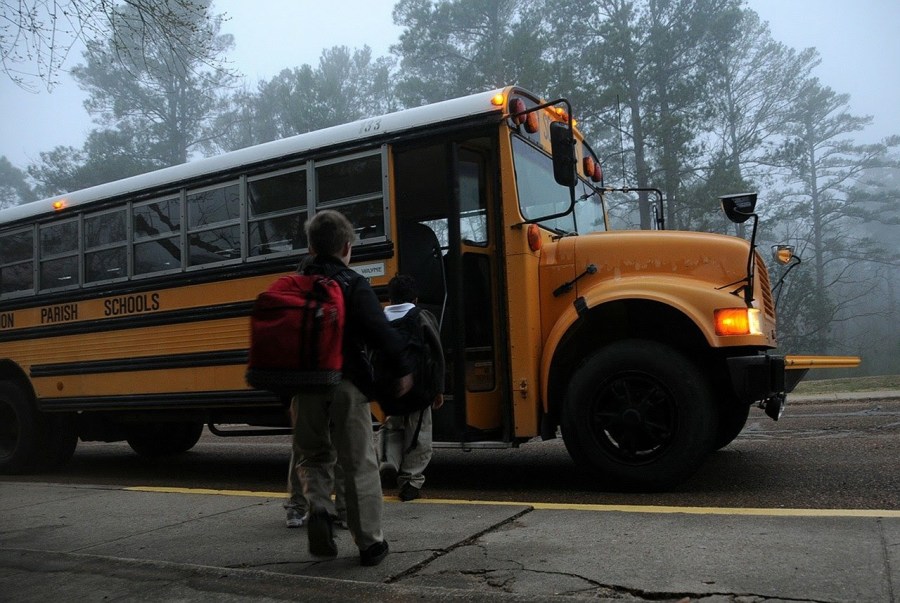Magic School Bus Rides Again List of Episodes

Y'all see them everywhere: those yellow school buses, taking kids to and from classes and field trips. They seem similar big behemoths every bit they get downward the route. In the U.s., there are actually four different types of buses that school systems can use, and federal regulations crave that they be no longer than 45 anxiety.
Types of School Buses in the United States
At that place are four types of school buses that meet safety standards and regulations in the United States. These buses are all different sizes and formats. A Type A bus is a smaller bus that is built on a van chassis but cutaway from a van size to accept a college capacity. These buses have a commuter'southward side front door and a larger double-decker entry door for passengers. Type B buses are small but built upon a coach body. The entrance door for everyone is located on the forepart rider side.
A Type C bus is called a "conventional" bus. Information technology's congenital on a flat chassis and has an engine located at the front end of the bus. These are the near common buses you lot'll see on the road. Type D buses are the largest in performance, and they accept an entry door at the front correct side. The engine on these buses can be in the front or rear.
T he History of School Transportation
Transporting students to school dates back to the 1880s; before that time, kids had to walk or notice other means to get to school. In 1886, the Wayne Works visitor of Indiana developed wagons for schoolhouse transportation. The visitor chosen these wagons "kid hacks" or "school hacks."
Wagon transport to schoolhouse didn't take off nationwide, only with the advent of the automobile, Wayne Works adult a motorized wagon in 1914. A. L. Luce, a Ford dealer in Georgia, developed the commencement motorized school motorbus in 1927, and he would later on develop Blue Bird Corporation, a leading manufacturer of schoolhouse buses. Three years later, Wayne Works adult a bus of their own, and they would become another leading passenger vehicle builder.
Due west hy Are School Buses Yellow?
One of the things everyone notices nearly school buses is the distinct yellowish color. Why are school buses painted this color, and where did the thought come up from? Schoolhouse bus yellowish dates back to 1939, when educator Frank Cyr revealed the results of his study of school buses in 10 states. Cyr discovered that various states had different types of buses, and some states were using trucks or equus caballus-drawn wagons to transport kids to schoolhouse.
Cyr proposed a national standard for school buses for consistency across the lath. When some people at the conference suggested that the United States paint buses cerise, white, and blue, Cyr balked and studied the best colour to become the attending of other vehicles. He placed 50 pigment samples around a room and discovered that the yellow color we now associate with school buses caught the eye better than whatever other color. Federal law doesn't require schoolhouse systems to pigment their buses the same color, so the xanthous school buses are voluntary.
S afety Features
School buses have a specific blueprint that ensures the rubber of everyone aboard. The concept of compartmentalization drives motorbus design, with the idea that passengers can be protected without seat belts, since seat belts aren't mandatory in the vast majority of school systems nationwide. The seats on school buses sit down loftier enough that most opposing vehicles are beneath the feet of passengers. Heavily padded seats provide cushioning on bear on, while aisle and rows of seats are close enough to each other that passengers don't move effectually much in the event of a crash.
Younger children sit three to a seat and older kids and adults sit two to a seat to prevent movement in a crash. Windows are higher on school buses than on other vehicles, and there are no windshields nearly passengers. Finally, school buses have multiple emergency exits to make it easier for anyone to become out.
R educing Environmental Impact
For a long time, modern schoolhouse buses accept relied on diesel as their primary fuel choice. Even every bit recently as 2017, over three fourths of school buses used diesel. That same twelvemonth, gasoline-powered buses became more prevalent, but they're still far in the minority. Alternative fuel school buses that run on natural gas are a much smaller piece of the pie, just they're bound to increase as school systems look for more environmentally friendly engineering science. Electric school buses are expensive, but they tin exist good solutions for urban school systems.
Source: https://www.reference.com/world-view/long-school-bus-feet-3c674c9adc10c1bd?utm_content=params%3Ao%3D740005%26ad%3DdirN%26qo%3DserpIndex
0 Response to "Magic School Bus Rides Again List of Episodes"
Post a Comment